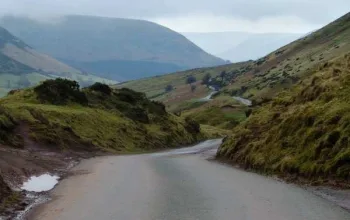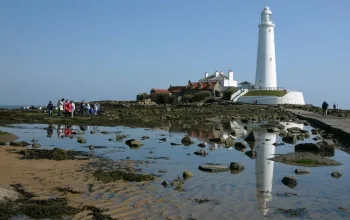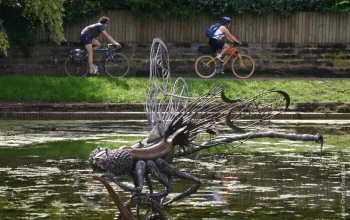In Britain a city is defined as a town containing a cathedral. This makes St Davids, with a population of just 1,600, by far the smallest city in Britain. Though small in size, it looms large in the history of Wales. The centuries after the Romans left is known as the 'age of saints', a time when missionaries travelled the Celtic world (Wales, Brittany, Cornwall and Ireland) spreading Christianity to people who mostly still held pagan beliefs.
Born in west Wales, St David founded 12 monasteries. Despite his aristocratic birth he was an ascetic and he required monks to plough, plant and tend crops without using animals; monks were to drink only water and eat only bread with salt and herbs; they were to renounce all personal possessions and, when not doing physical labour, spend their time in prayer or reading and writing.
It must have made for a hard life, though very much in tune with the rugged, windblown landscape of this most westerly corner of Wales. If there is such a thing as a Celtic landscape (and surely there is, from Santiago de Compostela right up to the Western Isles) then the north coast of Pembrokeshire is its archetype: a farmland interior, studded with rocky outcrops, that ends abruptly with steep cliffs of dark, volcanic rock. Every so often a fast-flowing stream plunges to the sea down a deep, lush ravine and crashing waves build up a fine sandy beach between towering headlands.
This ride begins out of St Davids on the A487 towards Solva, soon turning off the main road onto back lanes past a disused Second World War airfield that's now a nature reserve. Solva is a pretty village nestling in a narrow, pebbled inlet which, in geological terms, is a relatively newcomer, formed by melt water at the end of the last ice age.
The next section is a traverse of the Pembrokeshire interior initially following the River Solva inland. This is potato country and the Pembrokeshire Early - a delicately skinned new potato with a nutty flavour - recently joined Champagne, Parma ham and Melton Mowbray pork pies as geographically distinctive foods protected by European law. At harvest time big trailers carry the potatoes from field to farm and, bumping their way along the narrow lanes, they always drop a few out the back. I reckon it's finders keepers and I've had no trouble filling a pannier with the tasty tubers.
Just after Castlemorris the route crosses the Corsydd Llangloffan nature reserve, in the headwaters of the Cleddau Rivers, and exceptionally rich in both flora and fauna. Eventually the pastoral landscape gives way to more rugged coastal terrain. Up ahead rises a ridge crowned at its western end by the Garn Fawr hill fort. Though the road skirts to the side of the summit it's still quite a climb.
At the top you can see all the way to Strumble Head. This was the scene of the last ever invasion of Britain when, in 1797, the French army landed with a ragtag force of 1,400 men, including a lot of recently released convicts. They had banked on the oppressed Welsh joining them in the march on London, but it soon descended into farce as the invaders surrendered to the local militia after two days of chaotic drunken looting. From the lighthouse at Strumble Head, you can see seals bobbing in the water or lounging on the rocks. The eagle-eyed may also spot porpoises out at sea.
This is a ride of two halves and the return leg to St David's is perhaps the most glorious coastal route in Wales. It's all quiet lanes, occasionally dipping down to sea level, but there's no serious climbing to do.
The sunny, salty, quayside village of Porthgain is well worth the short detour and there are good swimming beaches at Abereiddy. The coastal road rolls along happily for mile after mile, until it arrives by an entirely unexpected back-door route right at the door of the Bishop's Palace in St Davids. The palace, which stands in ruins beside the cathedral, looks as though it was once fabulously grand. Somewhere along the line St David's wealthy and powerful medieval successors must have set aside the plain and simple life for which Wales's patron saint is revered.
For downloadable route info thebikeshow.net/21CC
This route was reproduced with kind permission from Jack Thurston and Wild Things Publishing.
 Lost Lanes Wales: 36 Glorious Bike Rides in Wales and the English Borders by Jack Thurston (£14.99, Wild Things Publishing) is available from all good bookshops.
Lost Lanes Wales: 36 Glorious Bike Rides in Wales and the English Borders by Jack Thurston (£14.99, Wild Things Publishing) is available from all good bookshops.
For 30% off and free P+P visit wildthingspublishing.com and enter 'Travel' as your coupon code.





















